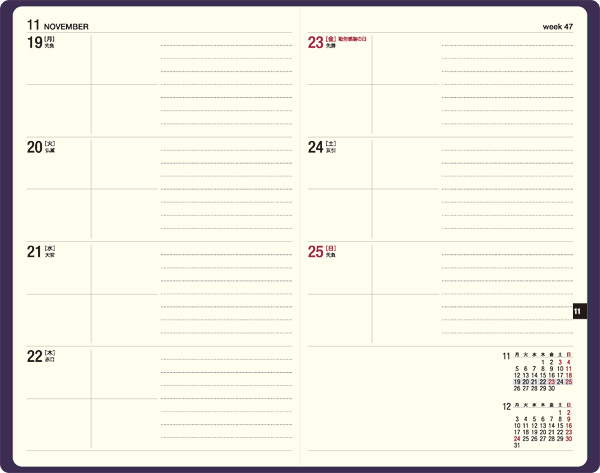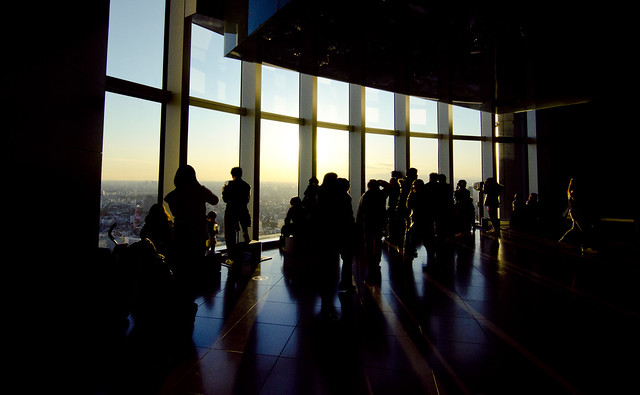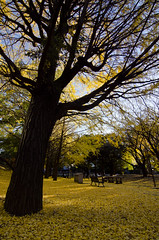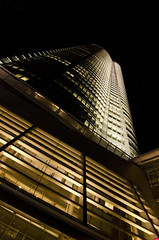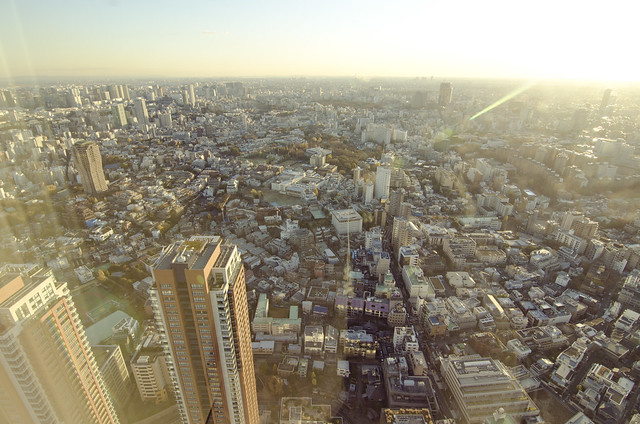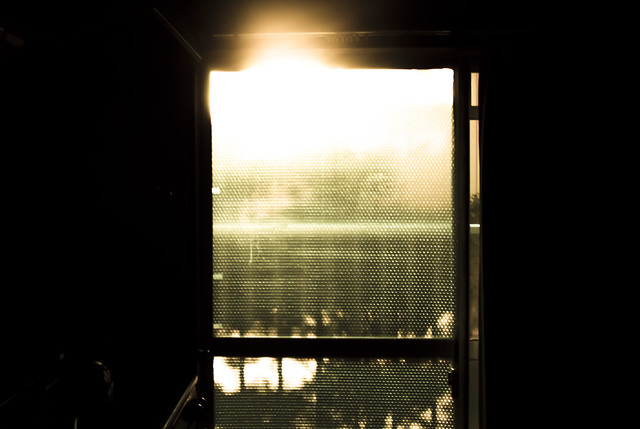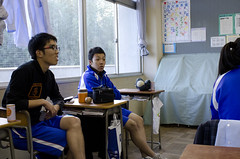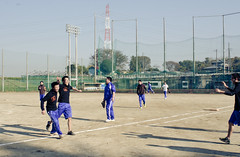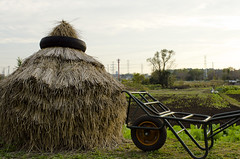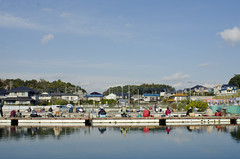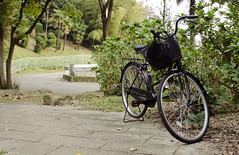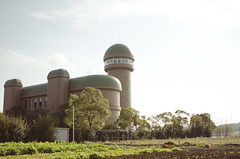Where in the snow an ox's
Path comes to its end.
Fast fact, Nick: did you know that the days after snow falls are actually colder than the day of snowfall? You see, while incidental factors (like heat-reflecting cloud cover and storm-related winds) may seem to suggest otherwise, the process of melting requires snow to absorb ambient heat-energy out of the atmosphere.
But that's nonsense. Of course you already knew that!

Also nonsense was that it’s already been one week since the first snowfall of the year... well, for Tokyo, at least, and, as everyone knows, it only counts if it happens in Tokyo. Ken and I celebrated
1because Japanese people always celebrate the firsts of everything: 初詣 (The First Visit to the Temple), 初日の出 (The First Sunrise), and 初夢 (The First Dream). Heck, they even have a thing for the "First Strong Breeze of Summer."
1 by meeting up with his Sig.Oth for a Fleet Foxes' concert at Studio Coast in Shin-Kiba, Tokyo. And because I am loathe to not celebrate absolutely anything ad infinitum, we went out again on Monday for some impromptu yakiniku, only mildly perturbed by the nipping cold and slight, though constant, rain. Ken was close to begging out, but I would not be put off Discount-Steak-Monday (certainly an event worthy of its own celebration).Anyway, so Ken was right, in that by the time we were walking home, the cold, heavy rain had turned to cold, heavy snow. But I've always been of the mind that snow is much better than rain. At least snowfall is better than rainfall
2In as much as snow has a "Magicalness" half-life best counted in minutes rather than days
2. Anyway, after being reassured that it never "really" snows all that much in Kashiwa, Mother Nature went on to say "oh yeah?" and dumped around three inches.Three inches may not sound like a lot both to people who have and have no sense of how much snow "three inches” is, but all we need to know is that “three inches” is enough to blow everyones' minds. I mean, they went crazy. It was such a big deal that, not only did the Tokyo Fire Department report 53 instances of snow-related injury by 10 a.m. the next morning, but it literally blew thoughts of Friday's "first" snow storm out of the social consciousness.
Nonplussed, both Ken and Karl were ripe to mention that we should try to catch the earlier bus to accommodate the more sensible Chiba-ians who'd decide to take the bus rather than venture cars and bikes on the narrow, unsalted roads of Japan.
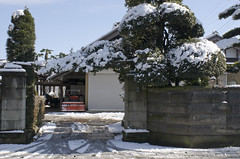

We adjusted accordingly and planned to be at the bus stop by 7:10 for the "7:21" bus. Verily
3I do not lie.
3, I gave away what very well was the "last spot" on the "early" bus to some old woman. Did it make me feel good about myself? A little. But not as much as I regretted not Heisman-ing her out of the way up the steps. But that is, as they say, neither here nor there. Certainly two more busses passed by the stop within the hour (no more than 20 or 30 minutes late), with neither stopping for passengers. At around 8:15, Ken suggested we skip the whole "bus" thing, catch a couple of trains that would find us slightly more north of our present location, and then proceed to walk the rest of the way.And that is what we did.
It was a little past 10 by the time we walked into the office, which, to our surprise, was full for the postponed teachers' morning meeting.
It has been a couple days since the Great Snowfall of 2012, and our schedule has just gotten over reeling from the White Menace
4Snow, not Sperry
4, especially as this week was supposed to be Finals Week for the 三年生, who, inexplicably, get two months off to "prepare" for college entrance exams.Anyway, what blew my mind was not the paltry amount of snow that danced across the streets in wisps like children, or how it put a stranglehold on normalcy in the Kanto region for days on end, but rather the hour I spent standing at the bus stop at 北柏駅.
Our stop is on a modest hill, one much steeper than I would like to walk on a daily basis, but no more steep than any random hill you could force any cross-country team to run in West or South Torrance. Then again, any hill of any size is steep enough for cars to lose traction when icy.
People do strange things when things don't go the way they expect them to. I could not tell you the number of cars that would slow to an eventual stall at the very foot of the hill thinking that gunning the accelerator would resolve the whole lack-of-traction problem
5"Constant thrust = constant speed!"
5. Granted, this would occasionally work and they would lurch ahead at a painstaking rate of inefficiency, only to return from their crawl to immobility inches later. I, literally, watched a delivery truck do this for an hour, deciding halfway up the hill to pull over to the curb and wait it out. What exactly he was waiting for is still unclear, but he waited.Also astounding were the number of idle pedestrians who went out of their way to help push these cars stuck in ice patches. If I were a better man, I would have stepped out of the bus line to help. After all, a car in the way is one more car blocking my bus. But, then again, if I were an even better man, I would have fired up the ol' Google Translate and translated me up some "Please stop. Please put your car in reverse and turn around. Go a different way. This is not the only road through Kitakashiwa. Thank you"
6Incidentally, GT suggests "中止してください。逆に車を置いて、向きを変えてください。別の道を行く。これは、北柏で唯一の道ではない。あなたに感謝。" Not coincidentally, this is not correct.
6.Whether it was obstinate pride or panic induced un-thought, both being double-plus un-good by the way, pretty much everyone would spend at least 10 minutes trying to gun it up the hill. And while that provided us all with an excellent visual demonstration of independent-wheel, anti-slip traction technology, people would try, try, try again, only to put their car in park and quit where they stood. I would like to think that it just didn't occur to them that turning around and going back down the hill was a perfectly viable option.
Certainly, this isn't unique to Japan: I've survived far too many rainy days on the 405 to know that Californians, too, can lose their minds when things don't go the way they're supposed to.

So, if I consider that most people responded the way they did because they had not considered that going back was an option (even to most of the helpful pedestrians, "forward" was the only way), I need to ask myself how long it would have taken me to finally get around to considering turning around as the best course of action.
I'd like to say that it would have come to me in a timely manner, but I can make no presumptions to think that I would have at all, were I ever to find myself in a similar situation. And I should not necessarily be ashamed of that. What I should be ashamed of would be, having watched this pattern of events for almost 90 minutes, not reassessing my own emergency-response methods to be sure that it includes a "backwards" option.
Actually, now that I think about it…
A few weeks ago I was in a classroom, as teachers are wont to do. I'm not quite sure when it was, except that I know that I was done with my instruction and was sitting down after doing a preliminary walk-through to make sure that everyone had understood and gotten started on the assignment.
So, anyway, I was sitting at my tiny teacher's desk, which is this tiny white-laminate TV tray of a table, when the whole building started to shake. Now having grown up in California and, thusly, a party to my fair share
7That's an American share, not a Japanese share.
7 of earthquakes, I quickly ascertained that we were in the midst of a mild 'shaker, which was fine. You know, besides the normal thoughts of "whoa" and "whoa-whoa," I realized that the students were looking to me and that I had no idea what I was supposed to do8Our earthquake preparedness drill was cancelled due to rain in October, to which the students were instead treated to an instructional video that the ALTs weren't privy to.
8.My initial play was to cool-hand it. After all, if I couldn't offer practical advice, I should at least provide emotional stability. The rumbling continued for a good 60 seconds and we rode it out in good spirits. Mid-way in one of them asked me if they should open the door and the window, to which I affected knowing and nodded my assent.
Before long, class was over, assignments were handed in and I was walking back into the office, off-handedly commenting how it was a real shame that the earthquake drill had been cancelled because I had no clue what I was supposed to do.
Come to think of it, I still don't. Well, at the very least I know that if there's an earthquake I should open the doors and windows.
That being said, after 90 minutes and still no bus, Ken suggested that we, ourselves, backtrack a little and take the train to 柏田中駅. So we did. And along the way found a French bakery.
So that was delicious.



